I had a fun conversation with the hosts of Red in the Face about mutual aid and more.
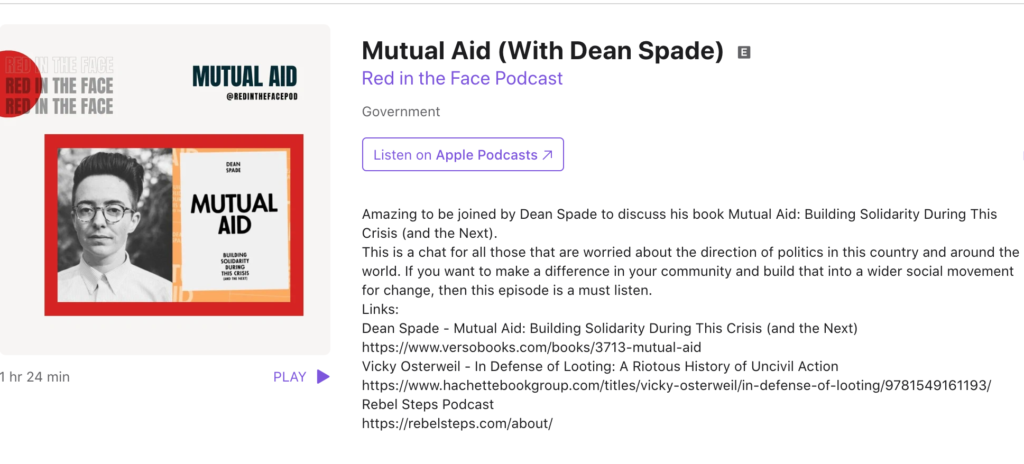
I had a fun conversation with the hosts of Red in the Face about mutual aid and more.

In case you missed it, Colin Kaepernick recently invited a bunch of abolitionist activists to write essays for a collection that his publishing platform has released over the course of the last four weeks in collaboration with Medium. The essays are really really really good–the whole collection would be a great syllabus for a class or reading group. I was honored to be included.
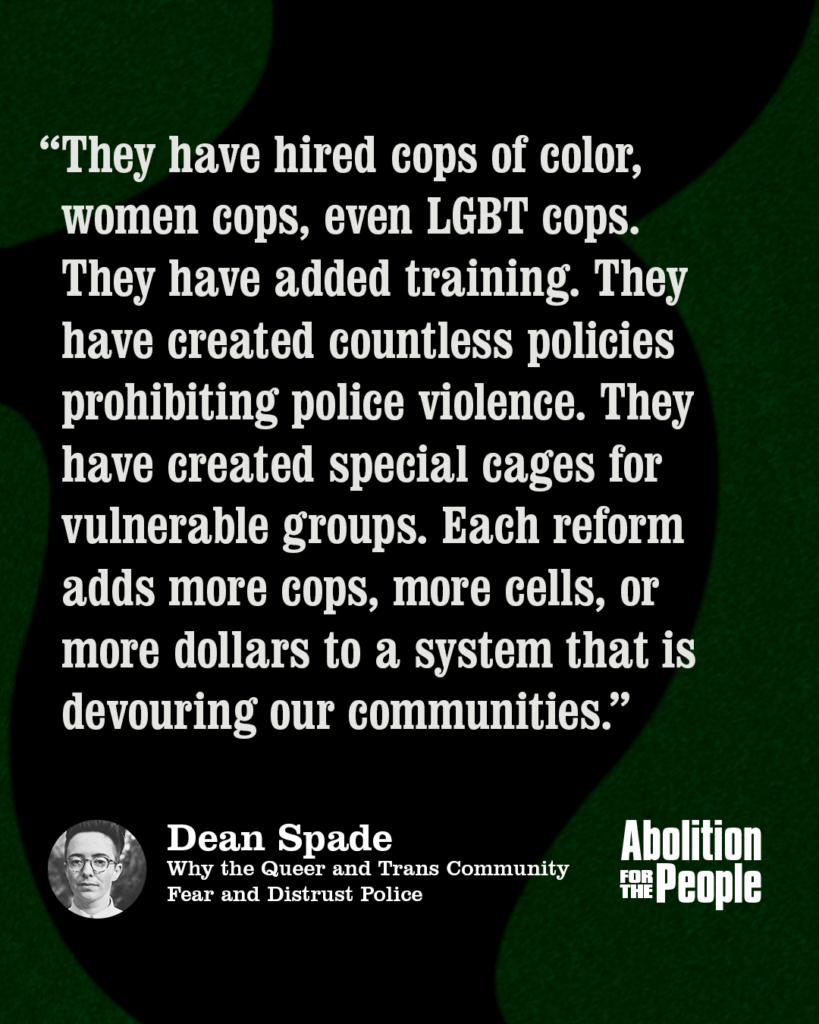
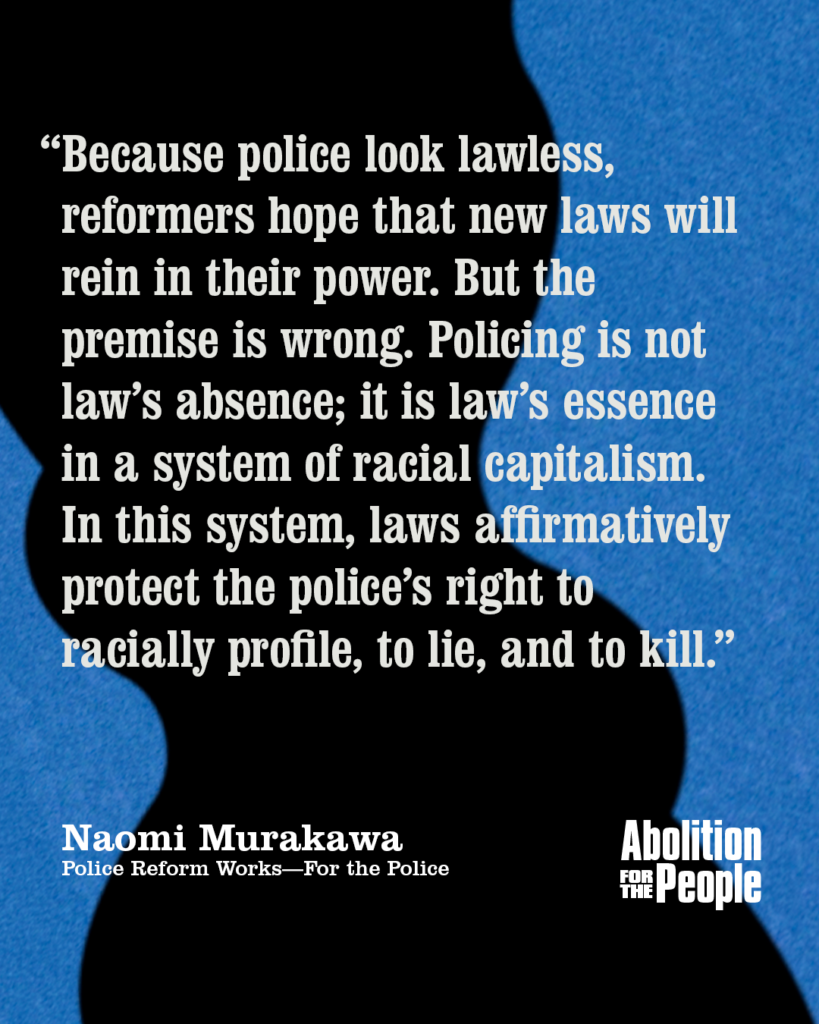
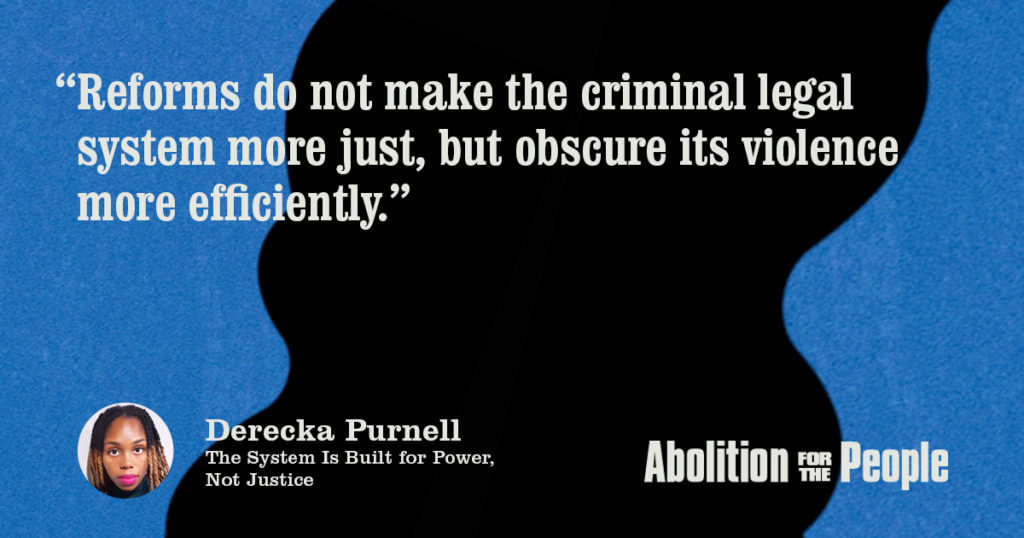
I am thrilled to be teaching Prison by Any Other Name this semester in Poverty Law. It’s exactly the right text for this moment, helping students get a wide and deep understanding of how police and prison reforms have failed to resolve problems and ended up expanding the very systems that cause them. I am writing reading questions for my students to help them ensure they are finding the themes in the text and to help them go back to the text throughout the semester. I offer this first set here in case they are useful to other people’s classes or reading groups using this book.
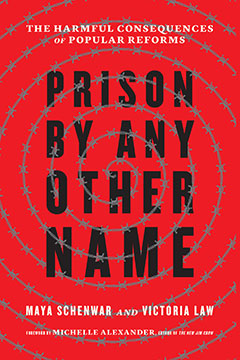
Reading Questions Prison By Any Other Name Intro and Ch 5
Introduction
Chapter 5
It was exciting to receive the new issue of Original Plumbing that includes an interview I mentioned before that has had me looking back at old zines and photos from the 1990’s and early 2000’s. Here is the text and some photos of how the editors laid it out in the magazine. Thanks to Amos and Rocco! 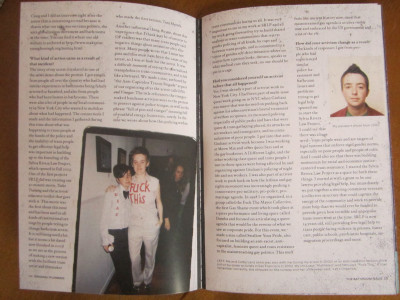
OP: Can you tell me what happened to you in Grand Central in 2002? DS: In February 2002, I attended the protest against the World Economic Forum meetings that were being held in New York City. It was a large anti-globalization protest, similar to the protests that had happened in 1999 in Seattle against the World Trade Organization, in Quebec City in 2001 against the proposed Free Trade Area of the Americas. These were all protests against summits where the rich and powerful gathered to plan economic policies that harm most people and the planet. It was also very shortly after the World Trade Center bombing on 9/11/01. The New York City government prepared for the protest by turning out the police in outrageous numbers. I participated in the protest with friends, and then we left. On our way home we decided to go to Grand Central Station to use the bathrooms because we had been out in the streets for hours and were in need. I went into the men’s a cop followed me, stopped me and asked for my ID. I explained that I was in the right place and I just needed to use the bathroom, and the cop started to arrest me. My friend Craig saw the cop follow me in and went in to see if I was okay. He and our friend Ananda who was nearby in the corridor both tried to intervene and advocate for me and they were arrested too. Others of our friend who were with us tried to get to us and were held back by a line of riot cops who showed up. We spent about 24 hours in jail. When we were transferred from the jail where we’d been to the cells at the court, a random court-appointed laywer came to talk to me about my arraignment. I had recently graduated law school but had never represented anyone in criminal court and didn’t really know what was going on or what was going to happen to me, or even whether or not I could actually be convicted of something. The lawyer who came to talk to me asked me about my genitals and when I told him I did not think it was relevant, he was mean and dismissive. It was really scary to see how even though, in so many ways, I was so privileged in this situation being a white person, employed, fancy-educated person, I felt really vulnerable in this system facing transphobia from the cops & the lawyer. Craig and I did an interview right after the arrest that is interesting to read because it shares what our take was on trans politics, the anti-globalization movement and bathrooms at the time.
OP: What kind of action came as a result of that incident? DS: The story of my arrest circulated as one of the news items about the protest. I got emails from people all over the country who had had similar experiences in bathrooms being falsely arrested or harassed, and also from people who had been beaten in bathrooms. There were also a lot of people in my local community in New York City who wanted to mobilize about what had happened. The connections I made and the information I gathered during this time about what was happening to trans people at the hands of the police and the inability of trans people to get effective legal help was important in building up to the founding of the Sylvia Rivera Law Project, which opened in Fall 2002. One of the first projects SRLP did was creating our 30 minute movie, Toilet Training and the activist/educator toolkit that goes with it. This movie was the first about this issue and has been used in all kinds of institutional settings by people trying to change bathroom access. It is still being used a lot, but it seems a bit dated now (finished in 2003) so we are in the process of making a new version with the brilliant trans artist and filmmaker who made the first version, Tara Mateik. Another influential thing, for me, about this experience that I think may be of interest to OP readers was that many trans people said negative things about me online after this arrest. Many people wrote that I must not pass and this must have been the cause of my arrest, so I was at fault for the arrest. It was a difficult moment of seeing the internalized transphobia in trans communities, and it felt like a betrayal. We made a zine, authored by “the Anti-Capitalist Tranny Brigade” as part of our organizing after the arrest called Piss and Vinegar. The title references the vinegar-soaked bandanas activists wore to the protest to protect against police teargas, as well as the phrase “full of piss and vinegar” meaning full of youthful energy, boisterous, rowdy. In the zine we wrote about how this policing within trans communities harms us all. It was very important to me in my work at SRLP and all my work going forward to try to build shared analysis in trans communities that rejects gender policing of all kinds, by cops and between trans people, and is committed to a vision of gender self-determination where no matter how a person looks, dresses, speaks or what medical care they seek, no one should be put in a cage. 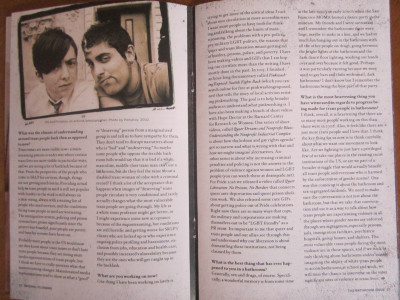
OP: Had you considered yourself an activist before that all happened? DS: Yes, I was already a part of activist work in New York City. I had been part of multi-issue queer work going on in NYC when Giuliani was mayor that was focused pushing back against his administration’s brutal treatment of welfare recipients, its increased policing (especially of public parks and bars that were queer & trans gathering places), its attacks on sex workers and immigrants, and its criminalization of poor people. I got into that anti-Giuliani activist work because I was working at Meow Mix and other queer bars and at the gay bookstore A Different Light, and the other working class queer and trans people I met in those spaces were being affected by and organizing against Giuliani’s policing of night life and sex workers. I was also part of activist work to push back on how the lesbian and gay rights movement was increasingly pushing a conservative pro-military, pro-police, pro-marriage agenda. In 1998 I co-organized, in a group called the Fuck The Mayor Collective, the first Gay Shame event which took place at a queer performance and living space called Dumba and focused on articulating a queer agenda that would be the reverse of what we saw at corporate pride. For this event, we made a zine called Swallow Your Pride, also focused on building an anti-racist, anti-capitalist, feminist queer and trans resistance to the mainstreaming gay politics. This stuff feels like ancient history now, since that mainstreamed gay agenda is so ultra visible now and embraced by the US government and a lot of the 1%.
OP: How did your activism change as a result? DS: The kinds of responses I got from people who had experienced similar police harassment and bathroom issues and problems trying to get legal help spurred me to start the Sylvia Rivera Law Project. I could see that there was a huge need–trans people were and are targets of legal systems that enforce rigid gender norms, especially on poor people and people of color. And I could also see that there was building momentum for racial and economic justice centered trans resistance. I started the Sylvia Rivera Law Project as a space for both these things. I started it with a grant to be one lawyer providing legal help, but immediately we put together a steering committee to create a collective structure that could capture the energy of the community and work to provide more help than we would ever be funded to provide given how invisible and unpopular trans issues were at the time. SRLP is now 14 years old, still providing free legal help to trans people facing violence in prisons, foster care, public schools, psychiatric hospitals, immigration proceedings and more.
OP: What was the climate of understanding around trans people back then as opposed to now? DS: Trans issues are more visible now–a mainstreaming process is under way where certain trans lives are more visible in particular ways, and we are seeing a lot of backlash because of that. From the perspective of the people who come to SRLP for services, though, things are not getting much better. Providing actual help to trans people in need is still not popular with funders so the work is still always on a shoe-string, always with a waiting list of people who need services, and the conditions facing trans people in need are worsening. The immigration system, policing and prison systems have grown significantly since the project was founded, poor people are poorer, and benefits systems have been cut. Probably more people in the US would now say they know about trans issues or don’t hate trans people because they are seeing more media representations of trans people, but I think we have to really question what that mainstreaming changes. Mainstreamed media representations tend to show us what a “good” or “deserving” person from a marginalized group is and tell us to have sympathy for them. They don’t tend to disrupt narratives about who is “bad” and “undeserving.” So maybe some people who oppose the terrible bathroom bills would say that it is bad if a white, masculine, middle class trans man can’t use a bathroom, but do they feel the same about a disabled trans woman of color with a criminal record? I think a lot of the acceptance that happens when images of “deserving” trans people circulate is very conditional and rarely actually changes what the most vulnerable trans people are going through. My life as a white trans professor might get better, or I might experience some new acceptance because of the mainstreaming, but conditions are still horrific and getting worse for SRLP’s clients who are locked up or who experience ongoing police profiling and harassment, exclusion from jobs, education and health care, and possibly increased vulnerability because they are the ones who will get caught up in the backlash. 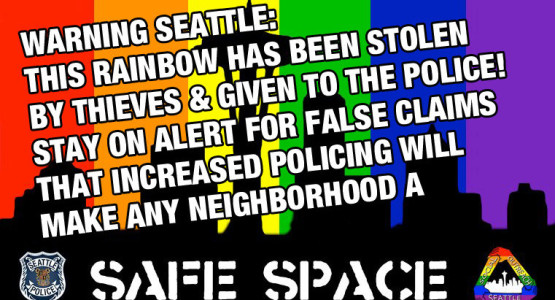
OP: What are you working on now? DS: One thing I have been working on lately is trying to get more of the critical ideas I care about into circulation in more accessible ways. I want more people to have tools for thinking and talking about the limits of mainstreaming, the problems with a pro-police, pro-military LGBT politics, the reasons that queer and trans liberation means getting rid of borders, prisons, police, and poverty. I have been making videos and GIFs that I am hoping can circulate more than the writing I have mostly done in the past. In 2015, I finished an hour-long documentary called Pinkwashing Exposed: Seattle Fights Back (online for free) that tells the story of local activists resisting pinkwashing. The goal is to help broader audiences understand what pinkwashing is. I have also been making a bunch of short videos with Hope Dector at the Barnard Center for Research on Women. One series of short videos, called “Queer Dreams and Nonprofit Blues: Understanding the Nonprofit Industrial Complex” is about how the lesbian and gay rights agenda got so narrow and what is wrong with that and how we might imagine alternatives. Another series is about why increasing criminal penalties and policing is not the answer to the problem of violence against women and LGBT people (you can watch these at deanspade.net). For Pride 2016 we released a video called “Queer Liberation: No Prisons, No Borders” that connects queer anti-deportation and queer prison abolition work. We also released some cute GIFs about getting police out of Pride celebrations. Right now there are so many ways that cops, the military and corporations are making themselves out to be “LGBT friendly” as a PR stunt. Its important to meet that queer and trans people and our allies see through this and understand why our liberation is about dismantling these institutions, not being claimed by them. 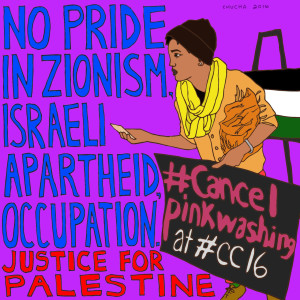
OP: What is the best thing that has ever happened to you in a bathroom? DS:Generally, sex and drugs, of course. Specifically, a wonderful memory is from some time in the late 1990’s or early 2000’s when the San Francisco MOMA hosted a dance party in the museum. My friends and I were on ecstasy and I remember the bathrooms there were huge, maybe 10 sinks in a line, and we had so much fun hanging out in the bathroom with all the other people on drugs, going between the bright lights of the bathroom and the dark dance floor lighting, washing our hands over and over because it felt good. Perhaps it was particularly exciting because we were used to gay bars and clubs with small, dark bathrooms? I don’t know but I remember the bathrooms being the best part of that party.
OP: What is the most heartening thing you have witnessed in regards to progress being made for trans people in bathrooms? DS: I think, overall, it is heartening that there are so many more people working on this than there were in 2002. Also, it feels like there are just more trans people and I love that. I think the key thing for us now is to think carefully about what we want our movement to look like. Are we fighting to just have a privileged few of us take our places in the existing racist institutions of the US, or are we part of a broader struggle that would actually benefit all trans people and everyone who is harmed by the enforcement of gender norms? One way this comes up is about the bathroom and sex-segregated facilities. We need to make sure the conversation is not just about the bathroom, but that we take that conversation and use it as a way to talk about how trans people are experiencing violence in all the places where gender norms are enforced through sex segregation, especially prisons, jails, immigration facilities, psychiatric hospitals, group homes, and shelters. The most vulnerable trans people facing the most violence are in these spaces, and if we stick to only thinking about bathrooms and/or mainly imagining the ability of white trans people to access bathrooms at school and work, we will miss the chance to intervene on the most significant sites of violence in trans lives.
Hope Dector and I have been making more things!
Animated GIFs featuring art by Micah Bazant. Please share!
Find them on Giphy here and here for sharing on facebook.
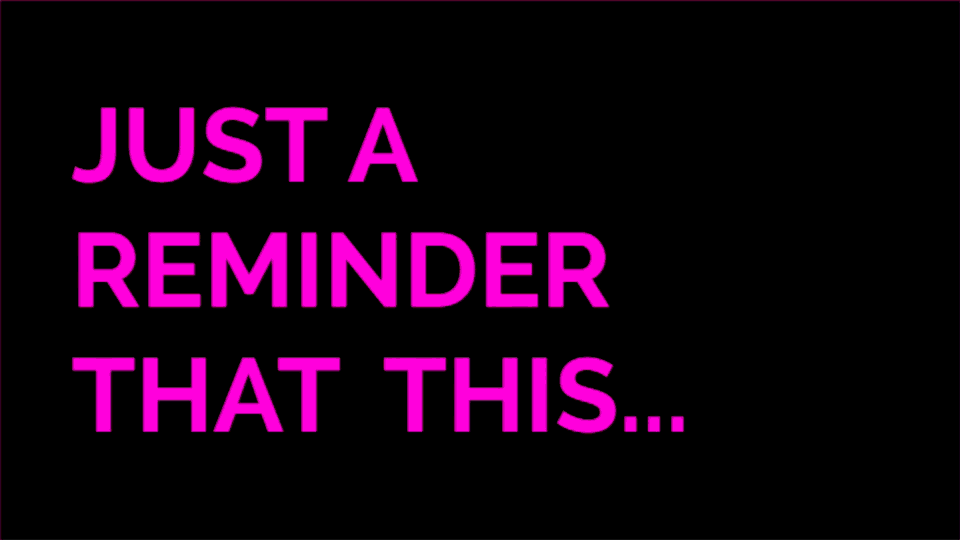
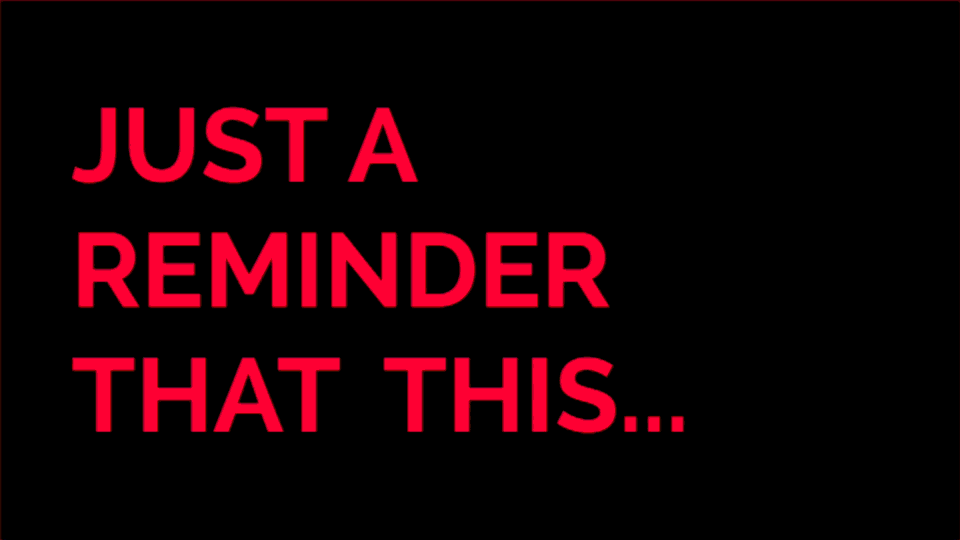
Queer Liberation: No Prisons, No Borders
Featuring Reina Gossett, Angélica Cházaro, CeCe McDonald, and Dean Spade. With art by Micah Bazant, Roan Boucher, Julio Salgado, Rommy Torrico, and Zuleica Zepeda.
On January 12, the National Gay and Lesbian Task Force issued an apology for including a panel by Immigration and Customs Enforcement (ICE) in the program of the upcoming Creating Change Conference. Familia: Trans Queer Liberation Movement, an organization that fiercely opposes the violence of immigration enforcement and has been part of the inspiring national #Not1More anti-deportation campaign, issued a response to the NGLTF apology: Apology Not Accepted. Familia refused NGLTF’s weak acknowledgement after the uproar that ICE’s inclusion in the conference had caused. The problem with ICE being on the Creating Change program is not just that it makes people feel unsafe (it is a no-brainer that you shouldn’t invite ICE to events where you want immigrant activists to be able to participate), it’s that ICE is a massive source of violence in the lives of queer and trans people and an institution that queer and trans activists are trying to end. Inviting ICE to participate in the conference suggests that there is some kind of collaboration sought, or that ICE can show up and be “LGBT-friendly.” Familia called out the reality that by including ICE, NGLTF ignored and rejected the clear anti-deportation, anti-immigration enforcement politics and strategy that has been articulated by queer and trans immigrant activists. We are not fighting for a gay-friendly border, a gay-friendly immigration prison or immigration raid. The only way for queer and trans immigrants to be safe is if raids, detentions, deportations and everything else ICE does ends.
There is another controversy brewing on the Creating Change program that presents a similar dynamic. The Israel advocacy organization, A Wider Bridge, is hosting a shabbat service and reception at Creating Change. A Wider Bridge aims to connect LGBT people in the US with Israel and promote the image of Israel as an LGBT tourism destination. It coordinates tours funded by the Israeli Consulate bringing LGBT Israelis to the US to talk about gay politics in Israel, it hosted a conference with many US LGBT leaders last summer in Israel and had those leaders participate in Gay Pride in Tel Aviv, it promotes Israeli-government funded films that portray Israel as a haven for gay rights in which Palestinians seek refuge, and it brings tours of LGBT people from the US to Israel. Its website proudly announces that it “led the LGBT contingent in New York’s Celebrate Israel Parade, and . . . marched with the Israeli Consulate in the New York Pride Parade.”
Queer and trans activists who are working to oppose Israeli colonialism and apartheid call this propaganda work “pinkwashing.” For over a decade, the Israeli government has been engaged the “Brand Israel” campaign, aimed to respond to the growing movement against apartheid in Israel by portraying Israel as “relevant and modern.” An important part of this effort has been to promote Israel as a gay-friendly country, touting the fact that gay people are allowed to serve in its brutal military and promoting Israel as a gay tourism destination. This message relies on Islamophobia and anti-Arab racism as Israel contrasts its supposed “gay-friendliness” with stereotypes of its homophobic neighbors, particularly portraying Palestinians as homophobic. Queer and trans activists around the world who oppose occupation and apartheid have called this propaganda strategy “pinkwashing” because it is a direct effort to conceal the extreme violence and harm that Israel inflicts on Palestinians, including queer and trans Palestinians, by promoting Israel as “gay friendly.”
In 2012, activists in Seattle got to know A Wider Bridge and its pinkwashing activities very intimately when A Wider Bridge partnered with the homophobic, right-wing organization Stand WithUs to bring an Israeli Consulate-sponsored pinkwashing tour to Seattle. Queer and trans Seattle activists pushed back, exposed the propaganda and got a planned tour event at Seattle City Hall canceled. We faced a very unpleasant backlash and made a film about our story (which you can watch for free online).
We made this film in hopes that it will help queer and trans people and people who care about queer and trans people to read and interpret propaganda that tries to play on our movements’ messaging to build PR for violent governments and institutions. Clearly, the organizers of Creating Change need some help with this–ICE and A Wider Bridge ended up on the program because they packaged themselves as dialoguing about LGBT issues. This is the new normal–police departments, prisons, the military, immigration enforcement and politicians and nefarious governments are all branding themselves as progressive, liberal and right-on with talking points about LGBT inclusion, meanwhile continuing their murderous work that harms queer and trans people and cannot be aligned with our liberation. When left movements across the US are calling attention to the racist violence of the immigration and criminal punishment systems, when more and more organizations are adopting resolutions to boycott and divest from Israel and the prison industry, queer and trans organizations have to get sharp about not becoming fig leaves or propaganda sites for institutions scrambling to prop up their tarnished images as their violence is exposed.
![[Image by Micah Bazant]](http://www.deanspade.net/wp-content/uploads/2016/01/pinkwash-flat-300x169.jpg)
My regret about our film, Pinkwashing Exposed: Seattle Fights Back! is that we did not focus enough on A Wider Bridge. At the time, it made sense to focus on how Stand With Us co-coordinated the events, because they are such an obvious right wing Israel advocacy organization which an insincere interest in queer issues that is only about the propaganda opportunities for Israel. It seemed like focusing on Stand With Us made the pinkwashing more obvious. In the months that followed the completion of the film, it became clear to me that we should have also focused on A Wider Bridge, whose pinkwashing strategy is more insidious. Many people who would be suspicious of explicit Israel advocacy because they have some vague sense that Palestinians are suffering under occupation are swept up in the friendly images of gay Israelis sharing their experiences and inviting people from the US to visit. Many people who know nothing about the occupation are learning about Israel from an Israel propaganda organization and not realizing it because it seems like a gay organization. A Wider Bridge denies that it is engaged in pinkwashing, but there is nothing secret about it being an Israel advocacy organization. It is not an organization focused on LGBT Jews, or an organization focused on LGBT Israelis, it is an organization focused on linking LGBT people in the US to Israel, the settler colonial nation engaged in apartheid, condemned by the world. It is an organization whose promotion of Israel is designed to make people think of Israel as a site of liberation and freedom rather than a regime producing colonization and genocide. As a Jewish trans activist who has sometimes attended Creating Change over the years, I like the idea of having a Shabbat service at the conference, but I do not want Creating Change to invite any Israel advocacy organization to lead it or host programming focused on promoting propaganda about Israel.
I believe that the organizers of Creating Change intend for the conference to be a place of progressive queer and trans politics–they would not want it sponsored by Wal-Mart, featuring workshops by gay climate change deniers, celebrating the leadership of gay conservatives. Over the years, there have been many, many controversies in which activists have called out the failures of the conference to live up to its progressive aims–most frequently regarding issues that impact queer and trans people of color. That is an important process and the work that activists have done to raise hell at Creating Change has forging new collaborations, changed queer and trans politics, and even changing the conference in some ways. Pinkwashing is now a ubiquitous and effective strategy for harmful institutions to promote a false image of themselves, and queer and trans activists have to sharpen our ability to discern it and hold organizations like NGLTF that purport to cultivate queer and trans liberation accountable when they partner with pinkwashers. The organizers who exposed the ICE participation in Creating Change won an important victory over pinkwashing by getting ICE taken off the program. Now NGLTF needs to take an active role in preventing pinkwashing of Israel at this year’s conference.
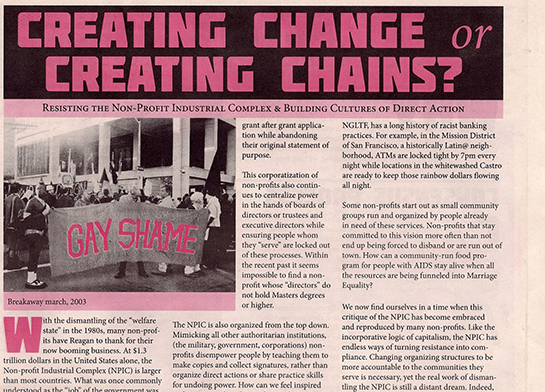
[Image from leaflet handed out by Gay Shame activists at Creating Change 2005 in Oakland.]
I wrote an article called “Intersectional Resistance and Law Reform” in Signs, published in 2013. You can read the full text online here, or download it here.
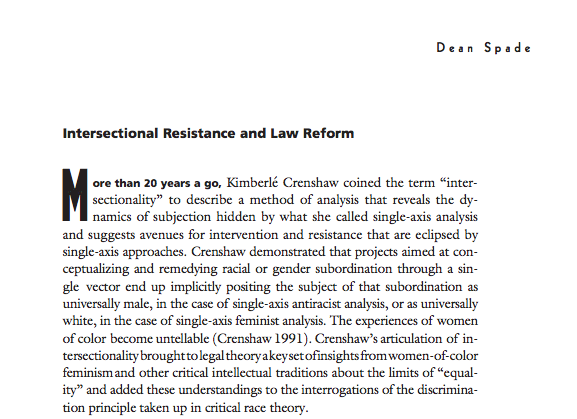
Abstract:
Critical race theory generally and intersectionality theory in particular have provided scholars and activists with clear accounts of how civil rights reforms centered in the antidiscrimination principle have failed to sufficiently change conditions for those facing the most violent manifestations of settler colonialism, heteropatriarchy, white supremacy, ableism, and xenophobia. These interventions have exposed how the discrimination principle’s reliance on individual harm, intentionality, and universalized categories of identity has made it ineffective at eradicating these forms of harm and violence and has obscured the actual operations of systems of meaning and control that produce maldistribution and targeted violence. This essay pushes this line of thinking an additional step to focus on the racialized-gendered distribution schemes that operate at the population level through programs that declare themselves race and gender neutral but are in fact founded on the production and maintenance of race and gender categories as vectors for distributing life chances. In the context of intensifying criminal and immigration enforcement and wealth disparity, it is essential to turn our attention to what Michel Foucault called “state racism”—the operation of population-level programs that target some for increased security and life chances while marking others for insecurity and premature death. This essay looks at how social movements resisting intersectional state violence are formulating demands (like the abolition of prisons, borders, and poverty) that exceed the narrow confines of the discrimination principle and take administrative systems as adversaries in ways that pull the nation-state form itself into crisis.
Paisley Currah and I co-edited the two-part special issue “The State We’re In: Locations of Coercion and Resistance in Trans Policy” in Sexuality Research and Social Policy: Journal of NSRC Vol. 4. No. 4 (December 2007) and Vol. 5, No. 1 (March 2008).
Read the introduction to the first volume here and read the introduction to the second volume here. A table of contents for both issues and links to most of the articles are below.
Part 1 (December 2007): Table of Contents
Introduction to Special Issue The State We’re In: Locations of Coercion and Resistance in Trans Policy, Part 1, Paisley Currah and Dean Spade
Unraveling Injustice: Race and Class Impact of Medicaid Exclusions of Transition-Related Health Care for Transgender People, Pooja S. Gehi and Gabriel Arkles
Sex Workers, Fem Queens, and Cross-Dressers: Differential Marginalizations and HIV Vulnerabilities Among Three Ethnocultural Male-to-Female Transgender Communities in New York City, Sel Julian Hwahng and Larry Nuttbrock
Seeking Refuge Under the Umbrella: Inclusion, Exclusion, and Organizing Within the Category Transgender, Megan Davidson
Transgender Health Benefits: Collateral Damage in the Resolution of the National Health Care Financing Dilemma, R. Nick Gorton
Momentum: A Photo Essay of the Transgender Community in the United States Over 30 Years, 1978–2007, Mariette Pathy Allen
Part 2 (March 2008): Table of Contents
Introduction to Special Issue The State We’re In: Locations of Coercion and Resistance in Trans Policy, Part 2, Dean Spade and Paisley Currah
Talking, Gawking, or Getting It Done: Provider Trainings to Increase Cultural and Clinical Competence for Transgender and Gender-Nonconforming Patients and Clients, Christoph Hanssmann, Darius Morrison, and Ellery Russian
Gender Identity and Hate Crimes: Violence Against Transgender People in Los Angeles County, Rebecca L. Stotzer
The Nonprofit Industrial Complex and Trans Resistance, Rickke Mananzala and Dean Spade
And by the Way, Do You Know He Thinks He’s a Girl? The Failures of Law, Policy, and Legal Representation for Transgender Youth in Juvenile Delinquency Courts, Jody Marksamer